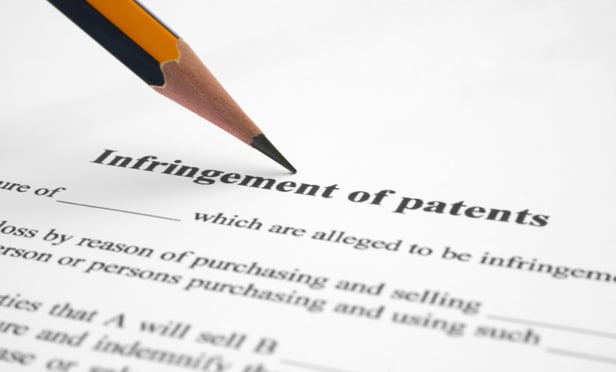Features

USPTO Continues to Demand Attorneys' Fees for District Court Appeals
Starting in 2013, the USPTO has been requesting reimbursement for the time spent by its attorneys and paralegals on district court challenges to PTAB and TTAB decisions.
Features

What 'Originalist' Viewpoints May Mean for Patent Law
The landscape for patent law has changed more quickly over the last five years than it had in preceding decades. Recent cases have profoundly changed the way courts and the USPTO treat patents and patent applications. The U.S. Supreme Court will have ample opportunity, if it chooses, to revisit the issues that have been raised by these cases over the next few terms.
Columns & Departments
IP News
District Court's Decision Retroactively Excusing Failure to Mark Patented Products Vacated By Federal Circuit<br>Federal Circuit Affirms PTAB's Unpatentability Findings Made In an IPR Proceeding Despite Prior Judicial Opinions Upholding Validity
Features

Supreme Court May Preserve EDTX Grip on Patent Cases
The U.S. Supreme Court did not appear eager to upset the patent litigation landscape by drastically limiting where infringement lawsuits can be filed.
Features
Supreme Court Ends Laches Defense in Patent Cases
<b><i>SCA Hygiene Products v. First Quality Baby Products</i></b><p>The U.S. Supreme Court on March 21 ruled laches is not a defense to patent infringement suits that are brought within the Patent Act's limitations period.
Features

Supreme Court Limits Patent Liability for Component Makers in Global Supply Chain
<b><i>Life Technologies v. Promega</b></i><br>In a decision that should please American manufacturers that feed into the global supply chain, the U.S. Supreme Court has narrowly interpreted a 33-year-old law that imposes patent liability on components made in the U.S. for assembly overseas.
Features

How Much Did the Federal Circuit Narrow Eligibility for Covered Business Method Review?
In November of last year, the Federal Circuit narrowed the types of patents eligible for covered business method review in <i>Unwired Planet, LLC v. Google Inc.</i> The court's decision narrowed what patents are eligible for CBM review, and provided some guidance for future cases.
Features

Amending Patent Claims in Post-Grant Trial Proceedings
<b><i>What You Need to Know</i></b><br>The America Invents Act gave patent owners the right to move to amend their patent claims. To date, however, this right has been more illusory than real. Given their dismal success rate so far, many hope that the tide will turn in favor of granting more motions to amend.
Features

Joint Infringement Post-Akamai: Understanding the Impact on Prosecution and Litigation Strategies<br><font size="-1"><b><i>Part 2: Decisions Since</i> Akamai <i>and Practice Insights</b></i></font>
Reviews the recent Federal Circuit <i>Eli Lilly</i> case as well as district court cases that have interpreted the new standard and identifies prosecution and litigation strategies for practicing post-<i>Akamai</i><p>
Features

Joint Infringement Post-Akamai: Understanding the Impact on Prosecution and Litigation Strategies
This two-part article aims to deconstruct the new joint infringement standard, provide insight into how the standard might be interpreted and provide practice tips for prosecution and litigation. Part 1 chronicles the <i>Akamai</i> cases that ultimately resulted in a new standard for joint infringement and explores the potential interpretations of that standard.
Need Help?
- Prefer an IP authenticated environment? Request a transition or call 800-756-8993.
- Need other assistance? email Customer Service or call 1-877-256-2472.
MOST POPULAR STORIES
- Second Circuit Reinforces Bankruptcy Code Settlement Payment Safe HarborThe Second Circuit affirmed the lower courts' judgment that a "transfer made … in connection with a securities contract … by a qualifying financial institution" was entitled "to the protection of ... §546 (e)'s safe harbor ...."Read More ›
- The DOJ's New Parameters for Evaluating Corporate Compliance ProgramsThe parameters set forth in the DOJ's memorandum have implications not only for the government's evaluation of compliance programs in the context of criminal charging decisions, but also for how defense counsel structure their conference-room advocacy seeking declinations or lesser sanctions in both criminal and civil investigations.Read More ›
- The DOJ's Corporate Enforcement Policy: One Year LaterThe DOJ's Criminal Division issued three declinations since the issuance of the revised CEP a year ago. Review of these cases gives insight into DOJ's implementation of the new policy in practice.Read More ›
- Questions Every Law Firm Business Development Leader Should Be AskingIn a legal marketplace transformed by technology, heightened client expectations, and fierce competition, law firm leaders must approach strategy with rigor and clarity. The following questions, accompanied by relevant statistics and explanations, offer a focused guide for uncovering opportunity and driving sustainable growth.Read More ›
- Use of Deferred Prosecution Agreements In White Collar InvestigationsThis article discusses the practical and policy reasons for the use of DPAs and NPAs in white-collar criminal investigations, and considers the NDAA's new reporting provision and its relationship with other efforts to enhance transparency in DOJ decision-making.Read More ›
